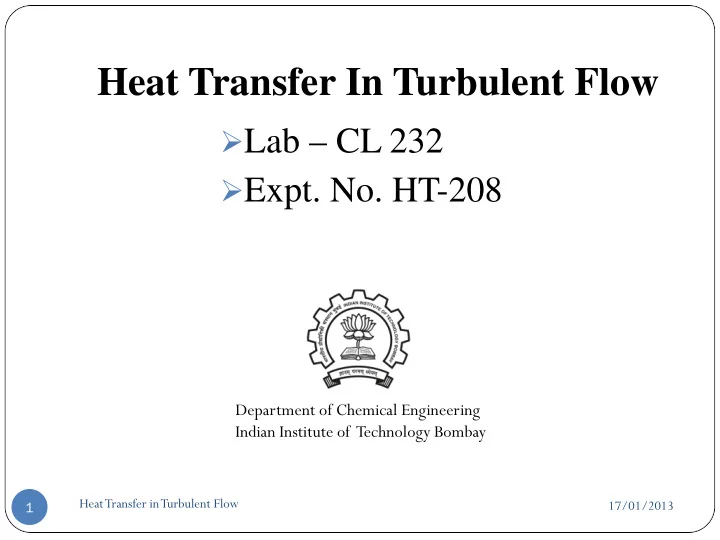

Heat Transfer In Turbulent Flow Lab – CL 232 Expt. No. HT-208 Department of Chemical Engineering Indian Institute of Technology Bombay Heat Transfer in Turbulent Flow 17/01/2013 1
Associated People Faculty Members: Prof. Jayesh Bellare List of TAs : Md Oayes Midda (114026003) ParundekarAkshay Narendra (114020011) Romil Shankey Mathew (08D02036) Lab Staff Members: Mr. S V Deshpande Heat Transfer in Turbulent Flow 17/01/2013 2
Aims of the experiment To determine the overall heat transfer coefficient making use of logarithmic mean temperature difference (LMTD). To determine the individual film heat transfer coefficients and verify Dittus-Boelter equation for turbulent flow heat transfer. Heat Transfer in Turbulent Flow 17/01/2013 3
Background Theory Overall resistance = sum of resistances in series ∆ 1 1 x 1 = + + U A h A KA h A i i i i lm o o ∆ (Hot) xA A 1 = 1 + + i i U h KA h A i i lm o o (Cold) Dittus-Boelter equation ( ) ( ) = 0 . 8 0 . 3 Nu 0 . 023 Re Pr ∆ 1 x 1 ( ) Nu = 0 . 8 h i A KA h o A const * velocity i lm o Final equation 1 1 = + const const 1 2 0 . 8 U i u 1 1 Plot (Wilson plot) vs 0 . 8 U i u Heat Transfer in Turbulent Flow 17/01/2013 4
Experimental Set-up Flow meter Digital display of temperature Double pipe heat exchanger Heat Transfer in Turbulent Flow 17/01/2013 5
Experimental Procedure Switch on the temperature indicator and controller. Check the 1) set point of the controller. The set point will be around 65 to 70 0 C. Start the hot fluid circulation pump. Initially keep the flow rate 2) at low speed by a regulator. Note down the temp difference between inlet and outlet temperatures, which gives zero error. After noting down the zero error, switch on the heater. Keep the cold fluid flow rate at 240 lph. Keep this flow rate 3) constant throughout the experiment. Heat Transfer in Turbulent Flow 17/01/2013 6
Adjust the hot fluid flow rate by regulator (the minimum flow 4) rate of hot fluid should be at least 40 cc/s, or 144 lph to maintain Reynold's number above 10000 in the heat exchanger). Note down the inlet and outlet temperatures of hot and cold 5) fluid after steady state is reached. Repeat step 4 & 5 for at least 6 different flow rates of hot fluid. 6) Heat Transfer in Turbulent Flow 17/01/2013 7
Data to be collected Dimensions of inner and outer tube of the double pipe heat exchanger. Physical properties of hot fluid (monoethylene glycol, MEG) at the set temperature (65 0 C). No of Hot fluid flow Hot fluid temperature Cold fluid temperature Obs rate (lph) ( 0 C) ( 0 C) Inlet (T 1 ) Outlet (T 2 ) Inlet (t 1 ) Outlet (t 2 ) 1 2 3 4 5 6 Heat Transfer in Turbulent Flow 17/01/2013 8
Data Analysis π Cross-sectional area of inner tube: = 1. 2 S 4 d 1 Inside heat transfer area of heat exchanger: = π 2. A d L 1 µ C p Prandtl number of hot fluid at mean temperature: 3. = Pr K V Velocity of hot fluid through heat exchanger: u = 4. S ( ) Amount of heat transferred: = ρ − 5. Q V * * C * T T p 1 2 Logarithmic mean temperature difference ( ∆ T lm ): 6. ( ) ( ) − − − T t T t = 1 2 2 1 LMTD ( ) − T t 1 2 ln ( ) − T t 2 1 Heat Transfer in Turbulent Flow 17/01/2013 9
Q Overall heat transfer coefficient: = 7. U ∆ A T 1 1 lm Plot ; and calculate outside film heat transfer 8. vs 0 . 8 U i u coefficient ( h o ) from the intercept. 1 Inside film heat transfer coefficient: = 9. h i 1 1 − U h i o Heat Transfer in Turbulent Flow 17/01/2013 10
THANK YOU Heat Transfer in Turbulent Flow 17/01/2013 11
Recommend
More recommend